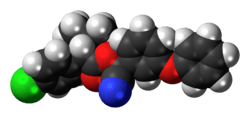Fenvalerate
 | |
 | |
| Names | |
|---|---|
| IUPAC name
(RS)-alpha-Cyano-3-phenoxybenzyl (RS)-2-(4-chlorophenyl)-3-methylbutyrate | |
| Identifiers | |
| 51630-58-1 | |
| ChEBI | CHEBI:5014 |
| ChEMBL | ChEMBL492491 |
| ChemSpider | 3230 |
| Jmol interactive 3D | Image |
| KEGG | C10988 |
| PubChem | 3347 |
| RTECS number | CY 1576350 |
| UNII | Z6MXZ39302 |
| |
| |
| Properties | |
| C25H22ClNO3 | |
| Molar mass | 419.91 g·mol−1 |
| Appearance | Yellow-brown viscous liquid |
| Density | 1.175 g/cm3 |
| 2 μg/L | |
| Pharmacology | |
| ATCvet code | QP53 QP53AX02 |
| Except where otherwise noted, data are given for materials in their standard state (at 25 °C [77 °F], 100 kPa). | |
| | |
| Infobox references | |
Fenvalerate is an insecticide. It is a mixture of four optical isomers which have different insecticidal activities. The 2-S alpha (or SS) configuration, known as esfenvalerate, is the most insecticidally active isomer. Fenvalerate consists of about 23% of this isomer.
Fenvalerate is an insecticide of moderate mammalian toxicity. In laboratory animals, central nervous system toxicity is observed following acute or short-term exposure. Fenvalerate has applications against a wide range of pests. Residue levels are minimized by low application rates. Fenvalerate is most toxic to bees and fish. It is found in some emulsifiable concentrates, ULV, wettable powders, slow release formulations, insecticidal fogs, and granules. It is most commonly used to control insects in food, feed, and cotton products, and for the control of flies and ticks in barns and stables. Fenvalerate does not affect plants, but is active for an extended period of time.
Fenvalerate may irritate the skin and eyes on contact, and is also harmful if swallowed.
References
External links
- Pyrethrins and Pyrethroids Fact Sheet - National Pesticide Information Center
- Esfenvalerate Pesticide Information Profile - Extension Toxicology Network
- Fenvalerate in the Pesticide Properties DataBase (PPDB)